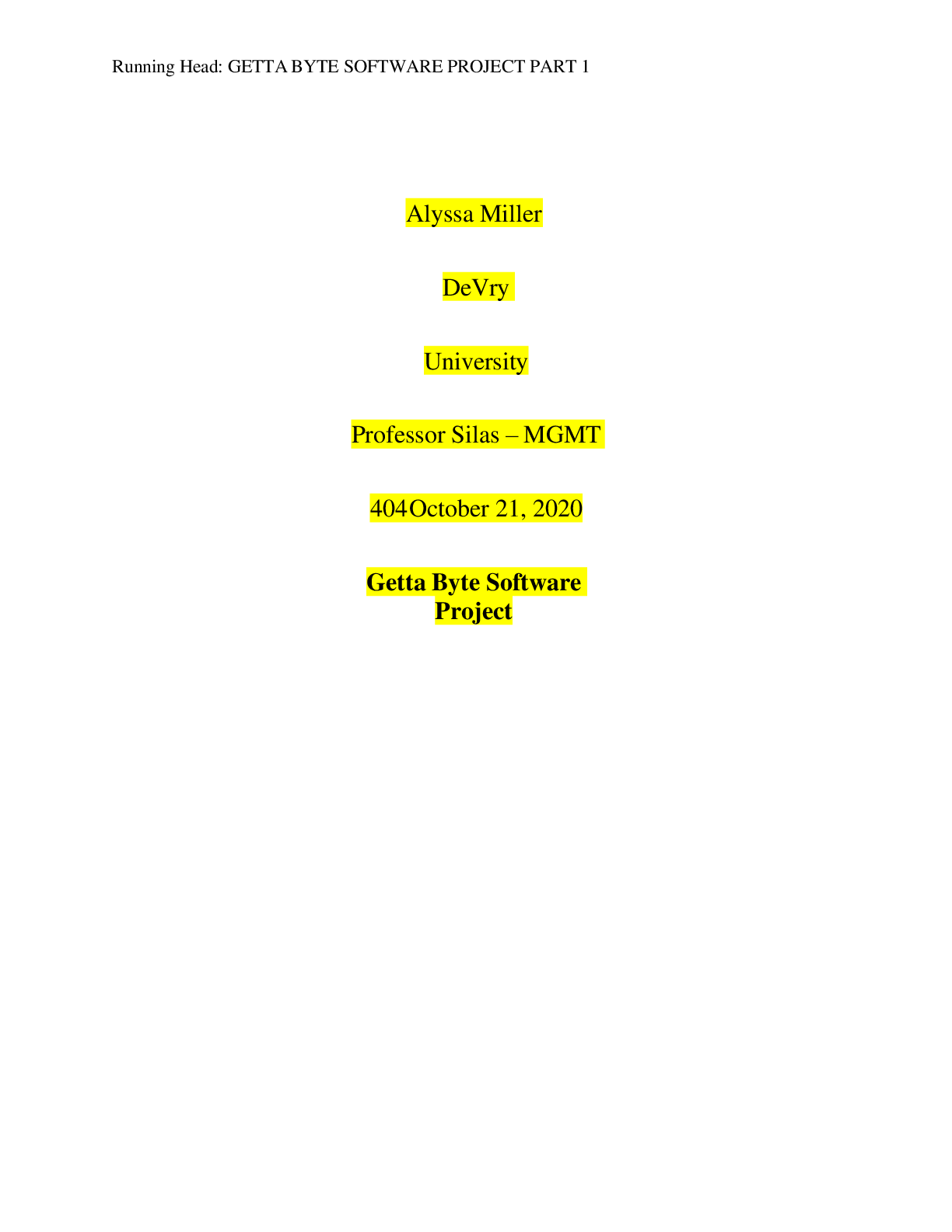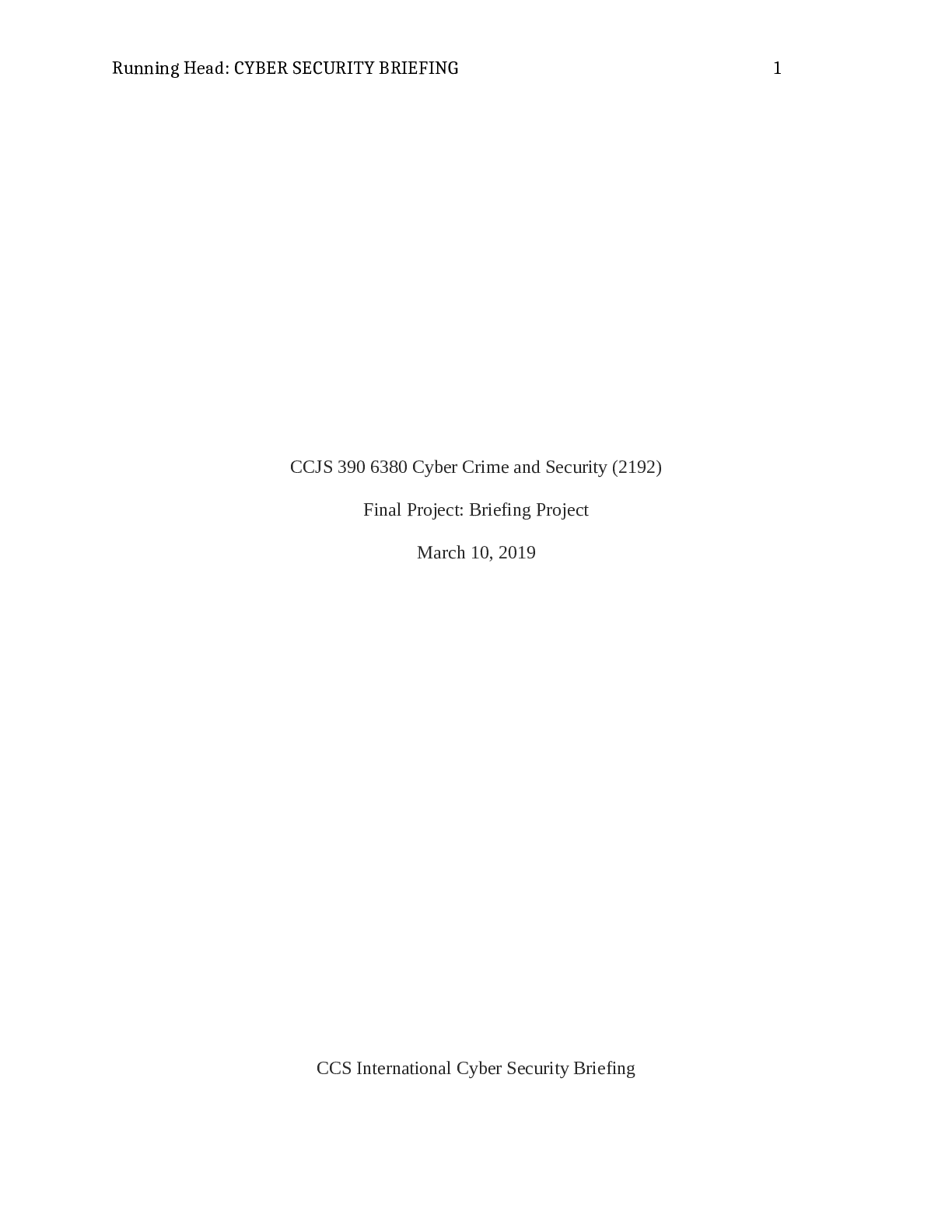Project Management > PROJECT FINAL > Capella UniversityMBA 5334PM-FPX5334_PalmerJared_Assessment4.2. (All)
Capella UniversityMBA 5334PM-FPX5334_PalmerJared_Assessment4.2.
Document Content and Description Below
Risk Management Plan Project Name: Virtual Team Risk Learner Name: Jared Palmer Course Name: PM-FPX 5334 – Project Risk Assessment and Control Date: 10/18/2020 Table of Contents Section 1 – ... Introduction to the Plan______________________________________________________________________________3 1.1 Benefits of Risk Management________________________________________________________________________________________3 1.2 Project Goals and Objectives_________________________________________________________________________________________3 1.3 Company Background______________________________________________________________________________________________3 1.4 Risk Identification_________________________________________________________________________________________________3 Section 2 – Risk Scope, Components, and Value_____________________________________________________________________3 2.1 Scope of the Risk Management Plan__________________________________________________________________________________3 2.2 Risk Management Plan Components__________________________________________________________________________________3 2.3 Expected Monetary Value___________________________________________________________________________________________3 2.4 Determine the Risks________________________________________________________________________________________________4 2.5 Evaluate and Assess the Risks________________________________________________________________________________________4 2.6 Qualitative and Quantitative Processes________________________________________________________________________________4 Section 3 – Risk Analysis and Assessment_________________________________________________________________________4 3.1 Major and Minor Risks_____________________________________________________________________________________________4 3.2 Risk Probability___________________________________________________________________________________________________5 3.3 Risk Matrix Template_______________________________________________________________________________________________5 13.4 Risk Data Quality Strategy___________________________________________________________________________________________5 3.5 Risk Reviews______________________________________________________________________________________________________5 Section 4 – Corrective Action and Monitoring______________________________________________________________________5 4.1 Risk Tolerance____________________________________________________________________________________________________5 4.2 Risk Mitigation____________________________________________________________________________________________________6 4.3 Corrective Risk Management Strategy_________________________________________________________________________________6 4.4 Corrective Action Plan______________________________________________________________________________________________6 Section 5 – Postmortem Plan____________________________________________________________________________________6 5.1 Results__________________________________________________________________________________________________________6 5.2 Follow Up________________________________________________________________________________________________________6 Section 6 – References_________________________________________________________________________________________7 6.1 References_______________________________________________________________________________________________________7 Templates___________________________________________________________________________________________________8 Risk Matrix Legend Example____________________________________________________________________________________________8 Risk Matrix Example__________________________________________________________________________________________________8 Risk Monitoring and Control Example____________________________________________________________________________________9 2Section 1 – Introduction to the Plan 1.1 Benefits of Risk Management Developing a risk management plan aids in attaining the objectives of a project. The following risk management plan identifies, assesses, and provides mitigation guidelines for risks facing virtual teams. As technology continues to evolve people are able to virtually connect in many ways. Adopting these technological solutions may benefit projects in the workplace but it also assumes risk. Using this risk management plan the organization may be able to recognize risks that are not overtly apparent, provide assessment of those risks for likelihood and impact, and develop responses to mitigate any loss. 1.2 Project Goals and Objectives Define the plan's goals and objectives as they relate to the evaluation of risk for a project. The goal of this project is to mitigate risks facing virtual teams. Consequently, this would allow the organization to effectively use virtual teams which have many potential benefits. Aspects such as employee safety, office space minimization, travel time mitigation, and others could be realized if an organization effectively uses virtual teams. As globalization continues to rise, organizations are no longer hindered by traditional work group boundaries such as geography or time (Regueira, 2016). Capitalizing on virtual teams involves evaluating the new risks associated. Some of the factors associated with virtual teams are communication, coordination, and technology (Regueira, 2016). Other goals for the virtual team risk mitigation project are improving these variables. 1.3 Company Background This project is applicable to many organizations attempting to take advantage of virtual teams. Typical beneficiaries of virtual teams range from the Board of Directors, if the organization becomes more efficient, to the customers, if the virtual team can perform at high quality. The role of the directors is to provide oversight and vision to the organization as a whole. The customers have a transactional relationship with the organization and the role of furthering the mission of the business in exchange for a product or service. Specific roles within this context are a project manager. It is the responsibility of the project manager to organize, plan, and allocate resources to meet the objectives of the project (Regueira, 2016). The group responsible for executing interdependent tasks is referred to as the project team. Individual team members have specific skill sets which contribute to the success of the project. This group executes to the scope of the project virtually through technological resources. This not only carries potential benefits but is very appropriate considering the current climate. The ability for teams to work virtually allows for safe social distancing keeping the workforce healthy and productive [Show More]
Last updated: 2 years ago
Preview 1 out of 16 pages

Buy this document to get the full access instantly
Instant Download Access after purchase
Buy NowInstant download
We Accept:

Reviews( 0 )
$15.00
Can't find what you want? Try our AI powered Search
Document information
Connected school, study & course
About the document
Uploaded On
Sep 25, 2021
Number of pages
16
Written in
Additional information
This document has been written for:
Uploaded
Sep 25, 2021
Downloads
0
Views
167













.png)

, Healthy Eating for Lifelong Healthy Lives, CAPSTONE COMMUNITY PROJECT.png)

.png)




